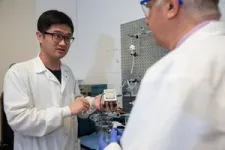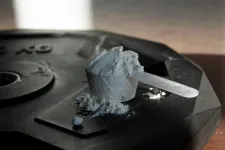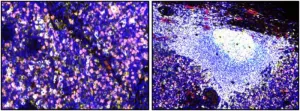(Press-News.org) LA JOLLA, CA—Current asthma treatments don't work in all patients, and they don't provide long-term relief from potentially deadly asthma attacks.
Scientists at La Jolla Institute for Immunology (LJI) are advancing a new kind of therapy. According to a recent study published in the Journal of Allergy and Clinical Immunology, their approach holds promise for providing long-lasting relief for people with asthma—and it may be useful for dampening immune inflammation in general.
The researchers have developed two therapeutic "cocktails" to stop immune cells from overreacting to allergens. The cocktails inhibit key molecules (called ICOSL, OX40L, and CD30L) that they found allow specialized tissue-resident memory T cells to stay active and maintained in high numbers in tissues. Without these molecules, the T cells can't trigger asthma attacks and do not persist to trigger future asthma exacerbations.
Even better, there are two effective versions of these cocktails. The researchers demonstrated that they could treat a mouse model of severe allergic asthma using either a combination of an ICOSL and OX40L inhibitor—or an ICOSL and CD30L inhibitor.
The researchers are hopeful that these two cocktails may one day give doctors the flexibility to help patients with different forms of allergic asthma.
"If we can target these molecules in human patients, they might be able to develop long-lasting tolerance to allergens," says study first author LJI Instructor Gurupreet Sethi, Ph.D., who led the study with support from LJI's Tullie and Rickey Families SPARK Awards for Innovations in Immunology.
"This study gives us insight into what could be two terrific options for helping asthma patients, but also might be applicable to other inflammatory diseases as well as autoimmune diseases" adds LJI Professor Michael Croft, Ph.D., senior author of the new study and a member of LJI's Center for Autoimmunity and Inflammation.
Funded entirely through philanthropy, The Tullie and Rickey Families SPARK Awards for Innovations in Immunology program follows a collective funding model. For Sethi, project support actually came directly from program co-benefactor and LJI Board Director David M. Rickey, as well as his family through The Brenda and Dave Rickey Foundation Charitable Trust. Beyond initial funding, the program also offers winner cohorts the opportunity to compete for follow-on investment. Among his cohort, Sethi was selected for the competitive second round of funding—once again made possible by the generosity of The Brenda and Dave Rickey Foundation.
Researchers track down key culprits behind asthma attacks
The new research builds on a 2022 study from the Croft Lab, which showed that blocking the T cell “co-stimulatory” molecules OX40L and CD30L at the same time could reduce asthma attacks in mice. This was an encouraging finding, but Croft suspected that additional co-stimulatory molecules contributed to asthma attacks.
The team uncovered clues in single-cell sequencing data, which revealed a lot of variation, or "heterogeneity," in T cells from human asthmatic lungs. Some of the T cells played bigger roles in lung inflammation—and they didn't all express the receptors for OX40L and CD30L in the same way.
With funding from LJI's Tullie and Rickey Families SPARK Awards for Innovations in Immunology, Sethi developed a mouse model with the same variety of T cells seen in asthmatic human lungs. Sethi was especially interested in investigating different subtypes of memory T cells. Memory T cells normally help the body by "remembering" past threats, such as viruses. But memory T cells pose a big problem for people with asthma, as well as being drivers of other inflammatory diseases.
"Memory T cells in the lungs are responsible for a patient's long-lasting, exaggerated response to an allergen," says Sethi.
Sethi discovered that a subset of memory T cells—called "tissue-resident memory T cells"—are in part controlled by another molecule, called ICOSL, that also serves as an important co-stimulatory molecule for these T cells during asthma exacerbations.
The researchers then tried blocking ICOSL activity alongside either OX40L and CD30L. Sethi found that around 50 percent of tissue-resident memory T cells remained in the lungs following treatment with a combination of OX40L and CD30L inhibitors. In contrast, only around 10 to 20 percent of tissue-resident memory T cells persisted after treatment with combinations of ICOSL and OX40L or ICOSL and CD30L inhibitors.
This big reduction in allergic tissue-resident memory T cells made a difference. Mice were protected against asthma exacerbations for weeks after either treatment, even when they were challenged repeatedly with an asthma trigger. It was like the researchers had erased the immune system's memory of the asthma-causing allergen.
Next steps: Targeting T cells to treat autoimmune diseases
Sethi says it will be important to investigate ways to further reduce the remaining 20 percent of allergic tissue-resident memory T cells in the lungs. He also hopes to advance both therapeutic "cocktails" to clinical studies in people with asthma.
The findings may prove important beyond asthma. As Croft explains, researchers have found that the same tissue-resident memory T cells accumulate in patients with a wide range of diseases. For example, these cells gather in the brain in patients with multiple sclerosis, in the skin in patients with atopic dermatitis, and in the gut in patients with inflammatory bowel disease.
"The idea is that if you can limit the number of memory T cells that remain in those tissues, you should be able to limit the extent of the inflammatory response, and you might be able to prevent future disease exacerbations. At present no approved drug treatment has been able to do this," says Croft. "The combination therapies that we have discovered might then pave the way for durable as well as effective treatments for multiple immune system diseases."
Additional authors of the study, "ICOSL, OX40L, and CD30L Control Persistence of Asthmatic CD4 Trm cells," include Ashmitaa Logandha Ramamoorthy Premlal and Ashu Chawla.
This study was supported by The Brenda and Dave Rickey Foundation through The Tullie and Rickey Families SPARK Awards for Innovations in Immunology and institutional funds from the La Jolla Institute for Immunology.
DOI: 10.1016/j.jaci.2024.12.1097
END
Stopping asthma in its tracks
New therapeutic "cocktails" may provide long-lasting relief for treatment-resistant asthma and other immune system inflammatory diseases
2025-02-19
ELSE PRESS RELEASES FROM THIS DATE:
Chlorine plus UV light degrades toxins caused by harmful algae blooms
2025-02-19
Treatment plants use a combination of tools to keep toxins and contaminants out of drinking water.
Researchers with the University of Cincinnati examined two such tools in addressing a toxin produced by harmful algae blooms, which are becoming increasingly common in waters around the world.
Blue green algae can reproduce en masse in waters laden with nitrogen, phosphorus or other excess nutrients. These algae “blooms” also can form when water levels drop during droughts or when bottom sediments heavy with nutrients get churned up in a storm, said Minghao Kong, a doctoral graduate of UC’s ...
In Denmark, rural cat owners are neutering their cats and allowing them indoor access
2025-02-19
Cat owners in the Denmark countryside are increasingly managing their cats in the same way as urban cat owners, resulting in fewer unwanted kittens being born, according to a study published February 19, 2025, in the open-access journal PLOS One by Peter Sandøe from the University of Copenhagen, Denmark, and colleagues.
Populations of unowned domestic cats – whether unsocialized feral cats that have never lived with humans, or socialized cats that have strayed or been abandoned – are regarded as problematic in many countries. It is argued that they are a nuisance, that they transmit disease to humans, owned cats and ...
Young people who use multiple muscle-building supplements are more likely to report symptoms of muscle dysmorphia
2025-02-19
Young people who use multiple muscle-building supplements are more likely to report symptoms of muscle dysmorphia, per Canadian study of more than 2,500 adolescents and young adults.
####
Article URL: https://plos.io/3EyuhD6
Article Title: Muscle-building supplement use is associated with muscle dysmorphia symptomatology among Canadian adolescents and young adults
Author Countries: Canada, France, U.S.
Funding: This study was funded by the Connaught New Researcher Award (#512586; KTG) at the University of Toronto. The funders had no role in study design, ...
A miniature swimming robot inspired by marine flatworms
2025-02-19
Swimming robots play a crucial role in mapping pollution, studying aquatic ecosystems, and monitoring water quality in sensitive areas such as coral reefs or lake shores. However, many devices rely on noisy propellers, which can disturb or harm wildlife. The natural clutter in these environments – including plants, animals, and debris – also poses a challenge to robotic swimmers.
Now, researchers in the Soft Transducers Lab and the Unsteady flow diagnostics laboratory in EPFL’s School of Engineering, and at the Max Planck Institute for Intelligent Systems, have developed ...
Natural hydrogen: a sustainable energy source in mountain ranges
2025-02-19
The successful development of sustainable georesources for the energy transition is a key challenge for humankind in the 21st century. Hydrogen gas (H2) has great potential to replace current fossil fuels while simultaneously eliminating the associated emission of CO2 and other pollutants. However, a major obstacle is that H2 must be produced first. Current synthetic hydrogen production is at best based on renewable energies but it can also be polluting if fossil energy is used.
The solution may be found ...
Scientists identify a new cancer immunotherapy target: Dysfunctional B cells
2025-02-19
University of Pittsburgh School of Medicine and UPMC Hillman Cancer Center scientists have discovered a novel subset of cancer-fighting immune cells that reside outside of their normal neighborhood – known as the tertiary lymphoid structure – where they become frustratingly dysfunctional when in close contact with tumors.
Described today in the journal Science Translational Medicine, the finding gives oncologists a new target for developing immunotherapies: double negative memory B cells, so-called because they are negative for two markers found on the surface of their more common brethren. They may also be a useful diagnostic ...
New Australian dinosaurs and the oldest megaraptorid fossils in the world
2025-02-19
Groundbreaking research published today in the Journal of Vertebrate Paleontology has unveiled a landmark discovery – fossils of the world’s oldest known megaraptorid and the first evidence of carcharodontosaurs in Australia. These finds rewrite the evolutionary history of theropod dinosaurs, uncovering a predator hierarchy unique to Cretaceous Australia.
The research, led by Museums Victoria Research Institute and Monash University PhD student Jake Kotevski, describes five theropod fossils discovered along Victoria’s coastline. The fossils were unearthed in the upper Strzelecki Group (Bunurong/Boonwurrung ...
EMBARGOED: Study reveals activity of navtemadlin in glioblastoma, points to possible treatment improvements
2025-02-19
Study Title: Window of opportunity trial reveals mechanisms of response and resistance to navtemadlin in patients with recurrent glioblastoma
Publication: Science Translational Medicine
Dana-Farber Cancer Institute authors: Veronica Rendo, PhD, Eudocia Q. Lee, MD, MPH, Veronica Rendo, PhD Patrick Y. Wen, MD, Keith L. Ligon, MD, PhD, Rameen Beroukhim, MD, PhD
Summary: Clinical research by Dana-Farber scientists suggests that combining a novel agent called navtemadlin with DNA-damaging chemotherapy for the treatment of glioblastoma, a form of brain cancer, could increase efficacy. Navtemadlin ...
Kimberly Stegmaier named as Pediatric Oncology Chair at Dana-Farber
2025-02-19
Boston - Kimberly Stegmaier, MD, was named Chair of Pediatric Oncology at Dana-Farber Cancer Institute and Associate Chief of the Division of Hematology/Oncology at Boston Children’s Hospital, in an announcement made today. Her appointment is effective April 1, 2025.
Stegmaier, a Dana-Farber, Boston Children’s Hospital, and Harvard Medical School faculty member since 2002, Stegmaier is currently Vice Chair for Pediatric Oncology Research at Dana-Farber, Co-Director of the Pediatric Hematologic Malignancy Program at Dana-Farber and Boston Children’s Hospital, Co-Leader for the Dana-Farber/Harvard Cancer Center Leukemia Program, and a Professor ...
Human Immunome Project and Michelson Medical Research Foundation award $150,000 grants to three early-career scientists researching immunology and vaccines
2025-02-19
NEW YORK – The Human Immunome Project (HIP) and Michelson Medical Research Foundation (MMRF) have awarded Dr. Omar Abudayyeh (Brigham and Women’s Hospital; Harvard Medical School), Dr. Caleb Lareau (Memorial Sloan Kettering Cancer Center), and Dr. Yuzhong Liu (Scripps Research) the 2024 Michelson Prizes: Next Generation Grants.
The $150,000 research grants are awarded annually to support early-career scientists advancing human immunology, vaccine discovery, and immunotherapy research for major global diseases.
“Investing in bold, early-career scientists fuels the high-risk, high-reward ideas ...
LAST 30 PRESS RELEASES:
Scalable and healable gradient textiles for multi‑scenario radiative cooling via bicomponent blow spinning
Research shows informed traders never let a good climate crisis go to waste
Intelligent XGBoost framework enhances asphalt pavement skid resistance assessment
Dual-function biomaterials for postoperative osteosarcoma: Tumor suppression and bone regeneration
New framework reveals where transport emissions concentrate in Singapore
NTP-enhanced lattice oxygen activation in Ce-Co catalysts for low-temperature soot combustion
Synergistic interface engineering in Cu-Zn-Ce catalysts for efficient CO2 hydrogenation to methanol
COVID-19 leaves a lasting mark on the human brain
Scientists use ultrasound to soften and treat cancer tumors without damaging healthy tissue
Community swimming program for Black youth boosts skills, sense of belonging, study finds
Specific depressive symptoms in midlife linked to increased dementia risk
An ‘illuminating’ design sheds light on cholesterol
Who is more likely to get long COVID?
Study showcases resilience and rapid growth of “living rocks”
Naval Research Lab diver earns Office of Naval Research 2025 Sailor of the Year
New Mayo-led study establishes practical definition for rapidly progressive dementia
Fossil fuel industry’s “climate false solutions” reinforce its power and aggravate environmental injustice
Researchers reveal bias in a widely used measure of algorithm performance
Alcohol causes cancer. A study from IOCB Prague confirms damage to DNA and shows how cells defend against it
Hidden viruses in wastewater treatment may shape public health risks, study finds
Unlock the power of nature: how biomass can transform climate mitigation
Biochar reshapes hidden soil microbes that capture carbon dioxide in farmland
Reducing saturated fat intake shows mortality benefit, but only in high-risk individuals
Manta rays create mobile ecosystems, study finds
Study: Mixed results in using lipoic acid to treat progressive multiple sclerosis
Norbert Holtkamp appointed director of Fermi National Accelerator Laboratory
New agentic AI platform accelerates advanced optics design
Biologists discover neurons use physical signals — not electricity — to stabilize communication
Researchers discover that a hormone can access the brain by hitchhiking
University of Oklahoma researcher awarded funding to pursue AI-powered material design
[Press-News.org] Stopping asthma in its tracksNew therapeutic "cocktails" may provide long-lasting relief for treatment-resistant asthma and other immune system inflammatory diseases










